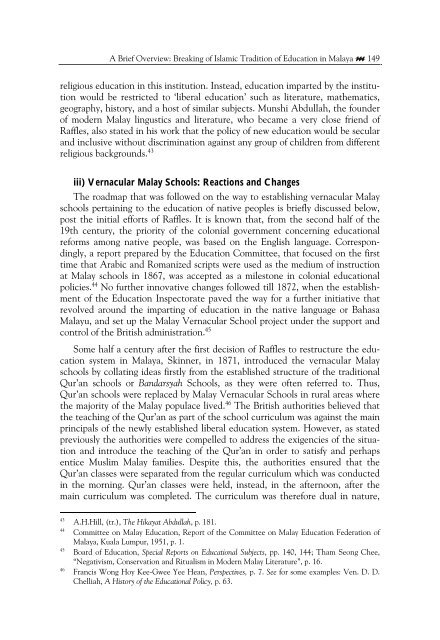İçindekiler - İlahiyat Fakültesi - Marmara Üniversitesi
İçindekiler - İlahiyat Fakültesi - Marmara Üniversitesi
İçindekiler - İlahiyat Fakültesi - Marmara Üniversitesi
Create successful ePaper yourself
Turn your PDF publications into a flip-book with our unique Google optimized e-Paper software.
A Brief Overview: Breaking of Islamic Tradition of Education in Malaya 149<br />
religious education in this institution. Instead, education imparted by the institution<br />
would be restricted to ‘liberal education’ such as literature, mathematics,<br />
geography, history, and a host of similar subjects. Munshi Abdullah, the founder<br />
of modern Malay lingustics and literature, who became a very close friend of<br />
Raffles, also stated in his work that the policy of new education would be secular<br />
and inclusive without discrimination against any group of children from different<br />
religious backgrounds. 43<br />
iii) Vernacular Malay Schools: Reactions and Changes<br />
The roadmap that was followed on the way to establishing vernacular Malay<br />
schools pertaining to the education of native peoples is briefly discussed below,<br />
post the initial efforts of Raffles. It is known that, from the second half of the<br />
19th century, the priority of the colonial government concerning educational<br />
reforms among native people, was based on the English language. Correspondingly,<br />
a report prepared by the Education Committee, that focused on the first<br />
time that Arabic and Romanized scripts were used as the medium of instruction<br />
at Malay schools in 1867, was accepted as a milestone in colonial educational<br />
policies. 44 No further innovative changes followed till 1872, when the establishment<br />
of the Education Inspectorate paved the way for a further initiative that<br />
revolved around the imparting of education in the native language or Bahasa<br />
Malayu, and set up the Malay Vernacular School project under the support and<br />
control of the British administration. 45<br />
Some half a century after the first decision of Raffles to restructure the education<br />
system in Malaya, Skinner, in 1871, introduced the vernacular Malay<br />
schools by collating ideas firstly from the established structure of the traditional<br />
Qur’an schools or Bandarsyah Schools, as they were often referred to. Thus,<br />
Qur’an schools were replaced by Malay Vernacular Schools in rural areas where<br />
the majority of the Malay populace lived. 46 The British authorities believed that<br />
the teaching of the Qur’an as part of the school curriculum was against the main<br />
principals of the newly established liberal education system. However, as stated<br />
previously the authorities were compelled to address the exigencies of the situation<br />
and introduce the teaching of the Qur’an in order to satisfy and perhaps<br />
entice Muslim Malay families. Despite this, the authorities ensured that the<br />
Qur’an classes were separated from the regular curriculum which was conducted<br />
in the morning. Qur’an classes were held, instead, in the afternoon, after the<br />
main curriculum was completed. The curriculum was therefore dual in nature,<br />
43<br />
A.H.Hill, (tr.), The Hikayat Abdullah, p. 181.<br />
44<br />
Committee on Malay Education, Report of the Committee on Malay Education Federation of<br />
Malaya, Kuala Lumpur, 1951, p. 1.<br />
45<br />
Board of Education, Special Reports on Educational Subjects, pp. 140, 144; Tham Seong Chee,<br />
“Negativism, Conservation and Ritualism in Modern Malay Literature”, p. 16.<br />
46<br />
Francis Wong Hoy Kee-Gwee Yee Hean, Perspectives, p. 7. See for some examples: Ven. D. D.<br />
Chelliah, A History of the Educational Policy, p. 63.



